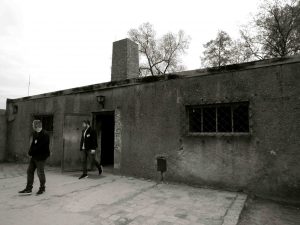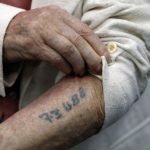
 Many people have tattoos these days, and the shops that perform their arts for people, have to comply with strict and sanitary working conditions. A tattoo performed in unsanitary conditions can become infected, and cause the loss of limb or even life, if it is not caught in time. The artwork these days is intricate and very elaborate. People can customize their tattoo so as to reflect their own personality. These days a tattoo is something lots of people use to express themselves, but tattoos were not always considered a thing of beauty, and was often forced upon people. Never was this more forced than during the Holocaust against the Jews.
Many people have tattoos these days, and the shops that perform their arts for people, have to comply with strict and sanitary working conditions. A tattoo performed in unsanitary conditions can become infected, and cause the loss of limb or even life, if it is not caught in time. The artwork these days is intricate and very elaborate. People can customize their tattoo so as to reflect their own personality. These days a tattoo is something lots of people use to express themselves, but tattoos were not always considered a thing of beauty, and was often forced upon people. Never was this more forced than during the Holocaust against the Jews.
Maria Ossowski was a Polish member of the Resistance imprisoned in Auschwitz in 1943. So many people did not survive, but those who did have lived to tell the truth about the Final Solution…Hitler’s most evil plot and crimes against humanity. Ossowski later recalled the horrible first few minutes of captivity and the tattooing process in the camp. Those people who did not die on the trains, or who were not herded straight to the gas chambers were herded into what they were told was their washroom. Ossowski says, “It was a huge barrack, with the water running, cold water I must add, from the top, there were men in already prison garb, which we never seen before. We were made to strip, we were made to go in front – each one of us – in front of that man, that man or the other one, they were all standing in the line, and we were shaven – we were shaven – our heads were shaven, our private parts were shaven and we were pushed then under that water. And after a while we were pushed out of it into another part of that big block, where the huge amount of terrible-looking – and already smelling terrible – clothes were prepared for us.”
Then they were given one dress with three-quarter sleeves that was put on over their heads. Once they were dressed, they were herded into another part, where female prisoners were sitting by little tables. Each had a job to do. They were to tattoo numbers on each prisoner’s arm. The tattoo process was not done in sanitary conditions, but it was done with an instrument that basically “wrote” the number into their arm. The instrument cut the skin and pushed ink under the skin. Ballpoint pens were not invented then, but the tool used acted in a 
 similar way. The process continued until the point and ink formed the shape of a number. Originally a sharp stamp was used, but it was impractical, and so they used the needle and ink method. Those who did receive a tattoo on arrival at Auschwitz might actually be considered “lucky” in that only those deemed fit for work were tattooed. The others were sent off for immediate execution. I doubt anyone who carried this forced tattoo considered it lucky.
similar way. The process continued until the point and ink formed the shape of a number. Originally a sharp stamp was used, but it was impractical, and so they used the needle and ink method. Those who did receive a tattoo on arrival at Auschwitz might actually be considered “lucky” in that only those deemed fit for work were tattooed. The others were sent off for immediate execution. I doubt anyone who carried this forced tattoo considered it lucky.


One Response to Forced Tattoo